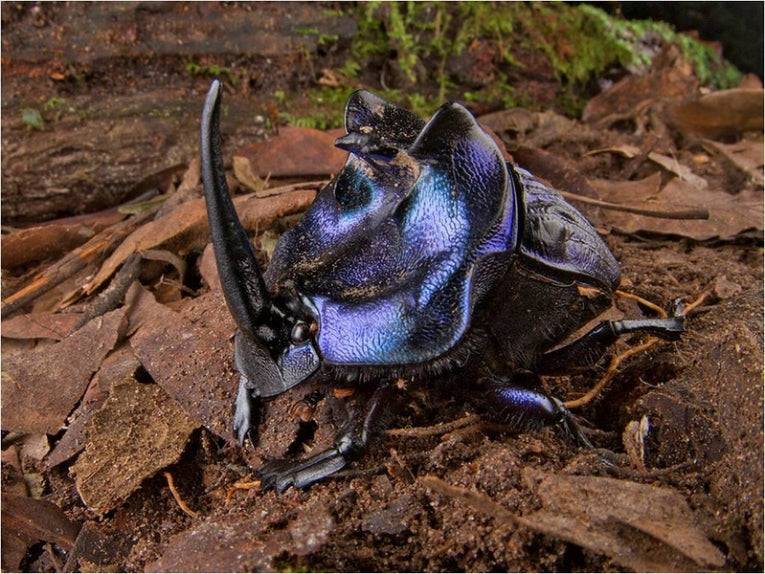Conservation International (CI) is a group who carry out rapid assessment programs in unexplored areas which desperately need to tell us what they have (in terms of biodiversity.) With the overpowering loss of habitats and organisms worldwide, this kind of project could turn out to be one of the most urgent tasks we have.
In the dark forests of the remote South American northlands, far south of Paramaibo, the latest survey has not surprisingly struck gold in the form of wonderful new species and many numerous specimens of otherwise rare creatures and plants.. Dr. Trond H.Larsen puts it best when he states, "Our team was privileged to explore one of the last remaining areas of vast, unroaded wilderness in the world. As a scientist, it is thrilling to study these remote lowland forests where countless new discoveries await, especially since we believe that protecting these landscapes while they remain pristine provides perhaps the greatest opportunity for maintaining globally important biodiversity and the ecosystems people depend upon for generations to come." The Amazon provides the world's greatest supply of vital freshwater, but these tributaries of the Courantyne (also known as Corantijn or Coeroeni river) have been preserved by wise governmental action in 1998. UNESCO was very impressed, giving World Heritage Site status to a central nature reserve.
In three weeks of 2010, researchers have unravelled some of the dense mystery of Kwamalasamutu, a tribal land and centre of the Trio people. They themselves were responsible for much of the expeditionary organisation, under the leadership of Granman Ashonko Alalaparoe and many of his people.

The RAP team at the Werehpai base camp, taken from the Conservation International release: An Armored Catfish, a 'Cowboy Frog', and a Rainbow of Colorful Critters discovered in Southwest Suriname; Credit: © Piotr Naskrecki
Dutch and US scientists combined with Suriname's universities to form the Rapid Assessment Program group. Ecotourism is bound to result from this specific work, while the local people have also found ancient petroglyphs from 5000 years ago in a local cave (Werehpai) to enhance the visitor experience but also the history of this little known area.
The many animals discovered are yet to be named in several cases. One"extinct" frog was found, after many years of zero sightings. The sheer numbers impress, especially viewing the complete data set:
Number of species recorded
Plants >240
Ants >100
Aquatic Beetles 144
Dung Beetles 94
Dragonflies and Damselflies 94
Katydids and Grasshoppers 78
Fishes 99
Reptiles and Amphibians 78

(Species not new to science) The Suriname horned frog or "Pac-Man frog" (Ceratophrys cornuta) is a voracious sit-and-wait predator. It has an exceptionally wide mouth, which allows it to swallow prey that is nearly as large as its own body, including mice and other frogs. This species was observed during Conservation International's Rapid Assessment Program in southwest Suriname - (An Armored Catfish, a 'Cowboy Frog', and a Rainbow of Colorful Critters discovered in Southwest Suriname); Credit: © Trond Larsen
Birds 327
Small Mammals 38
Large Mammals 29

(Species not new to science) The ocelot (Leopardus pardalis) is a medium sized cat, usually weighing up to 40 pounds. They are fiercely territorial and hunt small animals, especially rodents. - This species was observed by scientists working with Conservation International's Rapid Assessment Program in southwest Suriname - (An Armored Catfish, a 'Cowboy Frog', and a Rainbow of Colorful Critters discovered in Southwest Suriname); Credit: © Conservation International Suriname
Number of species new to science
Aquatic Beetles 16–26
Dung Beetles 10–14
Dragonflies and Damselflies 4
Katydids and Grasshoppers 7
Fishes 8

(Potentially new species): Imparfinis aff. stictonotus is a small catfish, only two inches long. Scientists caught it in a small, sandy stream in the Surinamese rainforest. They had to trek through dense jungle carrying heavy gear to find the stream where this new species occurred. This species was collected during Conservation International's Rapid Assessment Program in southwest Suriname - (An Armored Catfish, a 'Cowboy Frog', and a Rainbow of Colorful Critters discovered in Southwest Suriname); Credit: © Philip Willink
Reptiles and Amphibians 1

(Potentially new species): Hypsiboas sp. (nickname "cowboy frog") has white fringes along the legs and a spur on the heel. The frog was discovered low on a small branch during a night survey in a swampy area west of the RAP base camp at the Koetari River during Conservation International's Rapid Assessment Program in southwest Suriname - (An Armored Catfish, a 'Cowboy Frog', and a Rainbow of Colorful Critters discovered in Southwest Suriname); Credit: © Paul Ouboterk
New to Suriname itself were 111 of its impressive fauna (especially some beautiful beetles) and flora, soon to be embellished, I'm sure.
The large mammals include abundant ocelot and even jaguar, for which the conservation (and isolation) are to be thanked. Tourists will flood like the Orinoco (sorry, wrong river) when they hear that.
Conservation issues are of course predominant in the conclusions of the assessment. This very rapid assessment in the Kwamalasamutu region remarks:
(1) The forests in the surroundings of Kwamalasamutu seem to have a high conservation value. Eight species new for Suriname and a substantial number of rare species were discovered.
(2) The high conservation value is also demonstrated by the fact that one of the highest tree diversity values ever recorded for Suriname was recorded At the same time, the forests sampled at Werehpai had relatively low diversity values relative to other forests in Suriname and the Guianas.
(3) The majority of the forests in the surroundings of Kwamalasamutu are in a natural and healthy state. To ensure their continued health into the future, some matters need to be addressed in close cooperation with the Kwamalasamutu community. Agricultural change would be especially useful and possibly highly profitable in such a remote area with very few consumers. (ie. the population can be easily fed at the moment, but may be persuaded to adopt new ideas/crops/business concepts)










